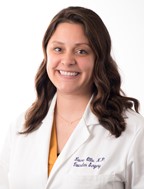Vascular Malformations
Vascular anomalies occur in barely one-percent (1%) of all births. Because of their rarity, diagnosing and treating vascular anomalies is challenging and difficult. UCSF vascular surgeons have extensive training and experience in the diagnosis and management of these and other rare conditions, serving as a major referral center for community physicians.
What are they
“Vascular anomalies” is an all-inclusive term for vascular malformations which can be subdivided into two groups: vascular tumors, and vascular malformations which are characterized based on the vessel type and type of blood flow. The more commonly used term, Congenital Vascular Malformation (CVM), implies blood vessels that were abnormally formed before birth.
Although it is redundant, CVM is a popular term. Birthmarks occur on the surface of the body and are relatively easy to manage. Other vascular malformations can develop from any type of blood vessel and develop in any part of the body, although the majority involve the extremities. They represent defects or development problems that occurred during embryonic growth.
Depending on the state of development at the time this occurs, the result can involve arteries, veins, lymph vessels, or combinations of these.
Birthmarks
The difference between a CVM and more common birthmarks such as a vascular tumor or hemangioma (the medical term), is very important to managing the effect on a child.
All birthmarks are not the same. Most birthmarks represent a superficial vascular malformation, consisting of abnormal collections of small blood vessels near the skin. Typically, this CVM type of birthmark does not go away nor does it enlarge, growing only at the same rate as the child. It thus maintains the same size and appearance indefinitely, is not a health threat, and requires no immediate treatment.
Some of them, because of their location, particularly around the face and neck or on some other exposed body part, are unsightly and cosmetically disturbing. Fortunately, the characteristic reddish color coincides with the range of certain lasers that can be used to remove them. Another approach has been to cover them up by tattooing them a skin color.
The other type of birthmark is actually a true vascular tumor or hemangioma. In contrast to a CVM, this type undergoes rapid growth in the months after its discovery, but then can get progressively smaller. The majority disappear completely in a few years, leaving behind a patch of shrunken elastic skin. This regression is normally completed between two and eight years of age, but not all of them completely disappear.
During their growth phase, these “juvenile hemangiomas” can be alarming, particularly if they grow in a critical location, such as those on the face impinging on the eye, nose, or mouth, in which case they may require treatment. However, most juvenile hemangiomas do not require treatment. Rather, the best advice is to do nothing but wait to see if it will resolve on its own.
Both of these types of birthmarks, or the remnants of them, can be greatly improved in appearance by plastic surgery if desired.
Arterial-Venous CVMs
During early developmental stages, large connecting channels or shunts between future arteries and veins exist, and a defect or arrest occurring at this stage may allow these artery-to-vein connections, or a cluster of them, to persist. Such connections are called arteriovenous fistulas (AVFs), or if there is a cluster of them they are called arteriovenous malformations (AVMs).
These are potentially the most serious type of CVMs, because in shunting blood from arteries to veins, they bypass the small vessels that make up the normal circulation beyond that point. This not only robs or steals blood that would otherwise pass through to more distant tissues and nourish them, but doesn’t allow for a gradual pressure drop from the high arterial pressure to the low pressure on the venous side. Thus, these AVFs represent a high flow short-circuit, and depending on their size and location they may respectively force the heart to work harder. They may also cause poor circulation in the limb beyond the point of the AVF.
In time, these AVFs tend to get bigger and have greater effect on the circulation. For example, an AVF or AVM in an extremity can “steal" (reduce) blood flow to a foot or hand as much as a blocked artery would. Fortunately, AVFs located in the legs and arms are more common than elsewhere in the body, and thus, easier to deal with. Those involving pelvic vessels, or vessels to vital organs or the brain can be extremely difficult to treat without injuring the organs or tissues they lie in.
Clearly, although AVFs make up only one third of all CVMs, they attract the most attention because of the more serious nature of the problems they create, and are the CVMs most likely to need interventional treatment.
Venous CVMs
CVMs composed entirely of veins, which are numerically the most common at almost half the total, are comprised of two basic types.
The more primitive ones appear as thin-walled lakes in which venous blood collects. When developing in groups or clusters, they may form a mass consisting of a collection of grape-like clusters of these venous lakes. This type usually does not affect the venous circulation which returns blood to the heart, but these masses of venous malformation can be unsightly and cumbersome, or they can become the site of blood clots (which fortunately, are not the kind that travel to the heart or lungs).
This type is usually more annoying than seriously threatening, but nevertheless, may be worth treating if the mass is large and causes local problems, such as interfering with walking.
The other type of venous defect involves the large deep or central veins, and often interferes with their function. Segments of major veins may be absent or narrowed, or segments may be greatly widened and expanded (dilated), called a venous aneurysm. Treatment is determined based on how severely they affect venous return, or contribute to deep vein thrombosis (DVT).
Most of the venous malformations involve only short venous segments and do not require treatment.
Arterial CVMs
Arterial defects or malformations are the least common type of CVM, being responsible for only 1 to 2% of the total. The most common arterial defect involves a segment that did not develop. The result is that a normal arterial segment is missing, and instead blood flows through a normally undeveloped side channel or collateral artery, which persists rather than withers.
Although this allows bypassing of the blockages, the enlarged bypassing segment often becomes more vulnerable to compression and injury, developing into an aneurysm or suddenly clotting off. The most common example of this is the so-called persistent sciatic artery.
Resources:









